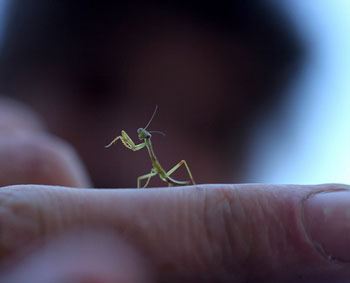Insects Make Good Use of Their Specialty Legs
By Chris Williams on May 20, 2014.
 The size and shape of an insect’s legs vary according to the insect’s habits. While the basic leg type is the simple walking leg seen on cockroaches and most beetles, many insects have at least one pair of legs that are modified for a special purpose.
The size and shape of an insect’s legs vary according to the insect’s habits. While the basic leg type is the simple walking leg seen on cockroaches and most beetles, many insects have at least one pair of legs that are modified for a special purpose.
Legs may be short and stout for digging (mole crickets, for example), long and muscular for jumping (fleas and grasshoppers), or have a dense fringe of hair for swimming (diving beetles), or carrying pollen (honey bees). The front legs of the praying mantis have spines and are modified for grasping prey. Head lice also have grasping legs that are designed to hold onto hairs. But regardless of its purpose, every leg is made up of the same basic parts (coxa, femur, tibia, tarsus, pretarsus) that are not that different from human leg bones.
With their 6 legs, insects can move in any direction and can walk on all kinds of surfaces. When an insect walks, it moves the middle leg on one side at the same time that it moves the front and back legs on the other side. It’s always balanced, like a three-legged stool.
Jumping Requires Muscular “Thighs”
Insects that are adapted for jumping, usually only have one pair of legs that are modified for that purpose. The other two pairs of legs are simple walking legs. Insects that jump have a greatly enlarged, muscular femur (like our thigh) on the hind leg. This muscle propels a grasshopper at a speed of 10 feet per second to a distance of 20 times its body length.
Like the grasshopper, the flea has extra large femurs on its hind legs. But these muscles aren’t the only thing that allow it to jump 130 times its own body length. The flea also stores an elastic protein in its joints which when released rapidly helps propel the flea forward like a spring.
Why the need for specialized jumping legs? Although jumping uses a lot of energy, particularly for larger insects, it allows them to move more quickly than does running or flying. Fleas need their jumping ability to be able to transfer from one animal to another, or to leap onto a moving animal from the ground. Some insects need their jumping ability to escape from predators. Some, like the jumping spider, are the predators themselves and jump to surprise and capture prey.
Photo credit: wouldpkr / Foter / Creative Commons Attribution-ShareAlike 2.0 Generic (CC BY-SA 2.0)